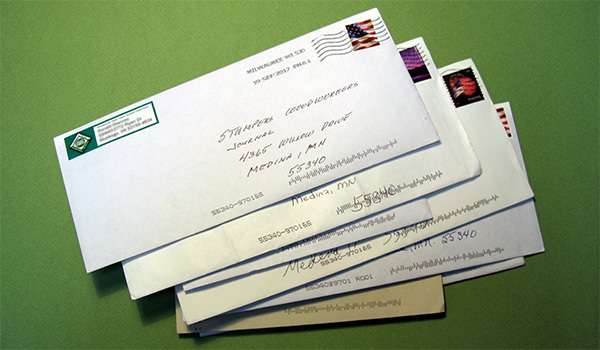
Last week Rob wondered about what your tried-and-true finishing methods are and if you sometimes change your finishing strategy. – Editor
“I’ve been making furniture for the past 60 years. Staining has always been a pain in the neck. I have found a way to make staining a lot easier and produce a better finish. I’ve taken the shellac pad concept and re-purposed it into a staining pad. Works great.” – Don Nolin
“I believe that the sign of a good tradesman is knowing what finish to aim for and where. For example, a dining table top needs an almost-polished finish, whereas the underside can be as rough as the proverbial bear’s backside. Even in metalwork, the craftsman needs to know where a polished finished finish is desirable and which surfaces are best left a bit rough.” – Rob Worrall
“Where the furniture piece will be indoors and dry, I use water-based lacquer or Odie’s Oil. On outdoor furniture where moisture will be an issue, I use spar varnish for doors and other really tough exposure areas. On food-prep surfaces and tabletops, I again use Odie’s Oil because it’s non-toxic and doesn’t water mark. I use a No. 4 smoothing plane or scraper for smoothing purposes.” – Ian Paige
“After years of frustration finishing pine and oak, I think I have found the perfect formula, for me anyway. I have always wanted an ‘antique’ finish for my pine projects but was never satisfied with the blotching, even with a preventive coat before hand. Now I use antique-pine colored aniline dye and and mix it with water. I follow that with a coat of shellac and paste wax. I also like the result on red oak.” – Marcel Corbeil
“I both brush and wipe on finishes. For me, it all comes down to the wood or project I am making and what I am putting on the project.” – Rudy Gonzalez
“I’m always looking to ‘up my game’ in the finishing business and have tried numerous techniques and finishes to get that perfect finished project. I probably started like most people with a can of varnish and a brush. That never really worked well for me because I had a tendency to apply too much product and then had to deal with runs and sags. More work! So, I’ve tried foam brushes, wipe-on cloths and spray finishing. All have resulted in varying degrees of success and failure. Foam brushes work pretty well on large surfaces, and I feel that I have a bit more control over the amount of finish I apply at any given time. I use cheesecloth most often because again, I can control the application process better. I bought a spray gun awhile back and initially had some success spraying cabinets outside under a canopy. Unfortunately, I live in the desert southwest where temps can swing 25 degrees between morning and afternoon and the humidity is typically low. As a result, the finish simply dries way to fast when temps are above 80 and humidity is below 15 percent, regardless of what type finish I use. I’ve also experimented with many different finishes. I’ve found varnish/oil blends work nicely, but the odor can permeate throughout the house, even if I’m applying finish in the garage. Oils are certainly easy to use, but they are not ideal for everything. Water-based lacquer was the go-to finish in the woodworking classes I attended, probably because it dries fast, but it wasn’t a practical solution for me because I’d see brush marks in the finish that simply took too long to rub out. Epoxy can be nice if you can work within the limitations of its working time and are okay with sanding out the drips that form on the bottom of table tops. I only use epoxy on outdoor furniture, by the way. Through all of this trial-and-error, I’ve come up with a short list of how I like to finish a project. Ultimately, the type of finish and method of finishing I use depends on the project and how/where it will be used. Probably my most used method is to apply a sealcoat of shellac with two to three coats of varnish wiped on over that. I like that shellac can add some extra color to the wood and provides some additional adhesion for the varnish. I’m currently applying a marine varnish/oil product to an outdoor bench, which is working good so far. I ended up finishing my kitchen cabinets with varnish and a foam brush, applying several coats for extra protection. Those actually turned out quite nice. Am I in the ‘better safe than sorry’ category? I don’t think so, because I’m still looking for a better way.” – Larry Schuh
“I’m currently in the ‘if it ain’t broke, don’t fix it’ category, but I’m open to new/better ideas and techniques as long as the definition of new/better includes ‘easier.’ I only know one way to finish a wood project, and that’s to stain it with oil-based Minwax and finish it with polyurethane. Can you teach this old dog a new trick?” – Don Lamothe
“I have found that I can get a very nice finish with Minwax Helmsman spar varnish. I thin the first coat with paint thinner, like a wipe-on, so that it fills all of the pores. I work with oak most of the time. With the wiping and the thinning, I don’t have the problem of fixing those little air pop holes. That base is the most important for a good start on a fine finish, and it also leads to less sanding. I sand down to 400- to 600-grit to start with, too.” – Lowell Taylor






